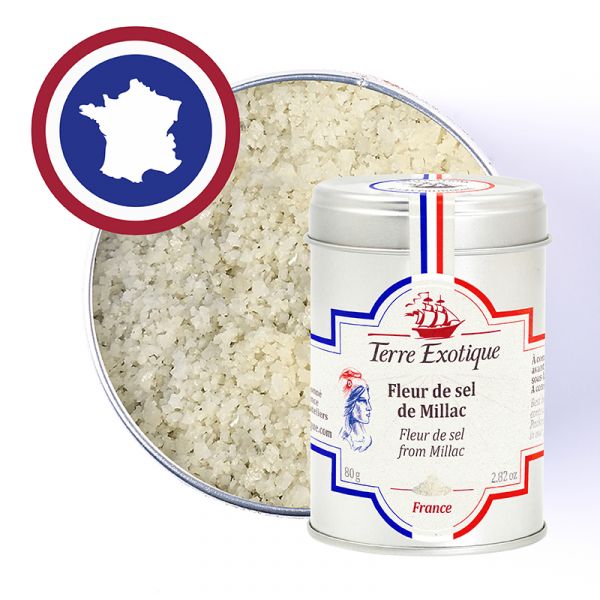



Where to use Millac fleur de sel
Millac fleur de sel will add a hint of iodine to your dishes. This 100% French fleur de sel has a distinctive bright white colour and a very delicate flavour a MUST in your kitchen and certainly on your table as a finishing salt!
How to get the best from your Millac fleur de sel
Our recipe ideas for this Millac fleur de sel:• Millac fleur de sel cookies: sprinkle a pinch of this fleur de sel on your cookies before baking (check out our recipe below);
• Millac fleur de sel biscuits: add 1 teaspoon of fleur de sel to your biscuit dough;
• Tournedos with a pinch of salt: after frying your tournedos, season with a pinch of fleur de sel;
• Tomato salad: sprinkle 3 pinches of fleur de sel over your tomatoes and enjoy;
• salmon “en papillote”: sprinkle a pinch of fleur de sel on your salmon then wrap up the kitchen parchment parcel and cook in the oven;
• Summer vegetable tart: arrange your vegetables on the pastry base and sprinkle with a few pinches of fleur de sel then cook in the oven.
Click to discover our cookie with a salty hint recipe;
A very delicate fleur de sel
Fine and gentle, you can add it at the end of the cooking process as it dissolves quickly. This wondrously pure salt will add a majestic salty hint to all your dishes.Millac fleur de sel, an outstanding French salt!
Harvested by hand by Emmanuel and Nathalie, this extremely white and fine Millac fleur de sel is produced using traditional methods in the Land of Retz in the former “Brittany Bay”. It is harvested in compliance with salt plant traditional methods and from March onwards Nathalie and Emmanuel will spend every day preparing the salt waters for the summer season. The water flows from the sea via channels into various salt ponds.The first pond is the “mestière” which is the first evaporation zone in the circuit. Then the water level changes and the water moves to the next level of ponds which act as a daily reserve supplying the final set of ponds, the “œillets” from which the salt is harvested.
This circuit takes about 2 days as the seawater evaporates slowly and the salt concentration increases. For the crystals to form, the water must reach between 250 and 280 grammes of salt per litre as opposed to 25 to 30 grammes per litre at the beginning of the circuit.
Once the fleur de sel starts to crystallize, it is carefully harvested using a special wooden rake.
This must be done rapidly as the fleur de sel crystallizes in the morning and drops down to the bottom of the saltwater pond in the afternoon under the heat of the sun and then transforms into coarse sea salt.
The history behind Millac fleur de sel
A salty and legendary terroir
The Land of Retz is located South of the Loire estuary, near the Atlantic Ocean where the former Brittany Bay was located. Nathalie and Emmanuel’s salty marshes are to be found in the historical salt producing town of Bourgneuf-en-Retz, where salt was traded all over Europe between the 12th and 16th centuries. The Millac salt ponds continue this age-old tradition to this day!| Price/kg | 130 |
|---|---|
| Allergen | Absence |
| Native country | France |
| Ingredients | fleur de sel from Millac |
| Nutritional Info | VN Energie pour 100 g (energy for 100g) : 0 kJ / 0 kcal VN Matière grasse (fat) : 0 g Dont acide gras saturés (of which saturated fat) : 0 g VN Glucides (carbohydrate) : 0 g Dont sucres (of which sugars) : 0 g VN Protéines (protein) : 0 g Vn Sel (salt) : > 94 g |
| Contenance | 80g |
| TRACES EVENTUELLES D'ALLERGÈNES | céleri, sésame, moutarde, fruits à coques. |
 Français
Français 